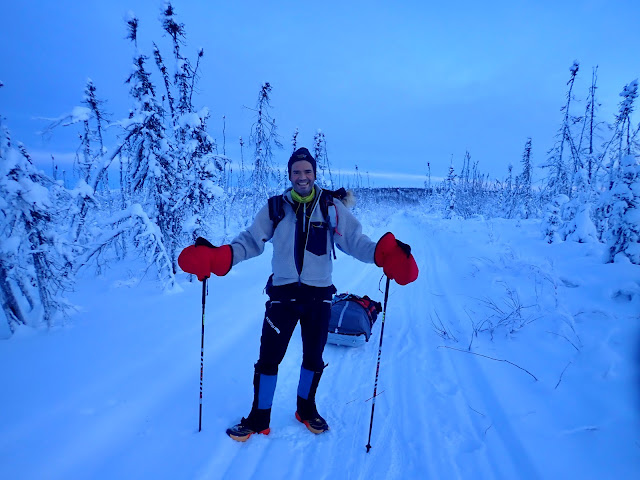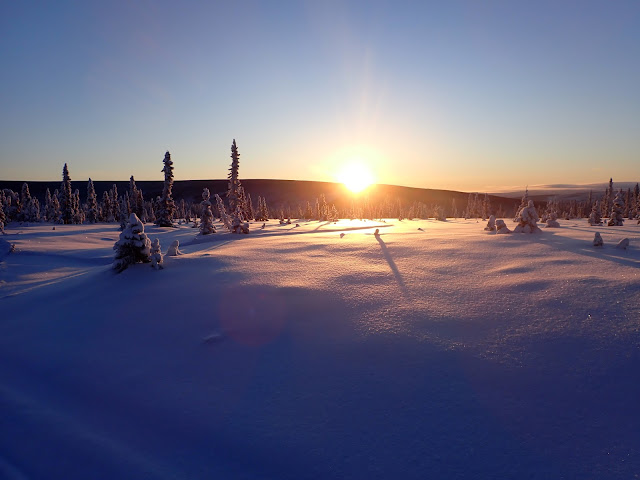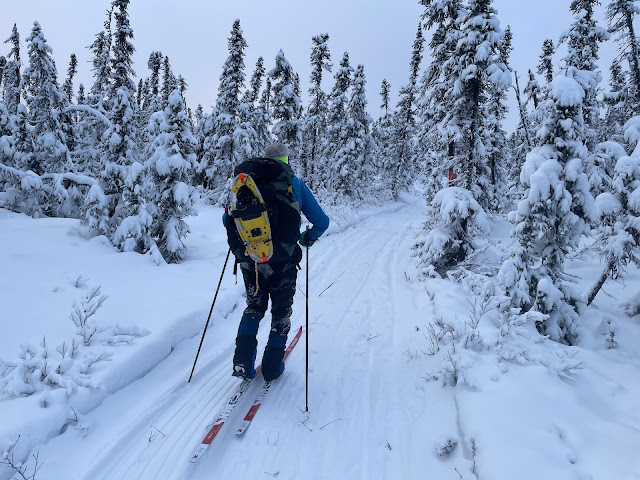Post by Corrine
This trip was not turning out well.
As I pushed my loaded bike through snowdrift after snowdrift, I turned around and finally saw Eric pushing his bike toward me. I trudged back towards him.
“What do you think about turning around instead of going to the cabin?” I asked when we finally met.
We were 11.5 miles into a 19-mile bike to Cache Mountain Cabin in the White Mountains National Recreation Area. Eric was still having a good time on (and off) his bike, but he thought for a few seconds said, “Sure, let’s go back.”
We headed back the way we had come, pushing our bikes through the drifts.
When Things Go South
Sometimes adventures don’t end up as planned. Being flexible is key especially when traveling with others.
We had done a three-day bikepacking trip in the Whites the weekend before to meet our friends, Beat (pronounced bay-ott) and Jill from Colorado. They are training for a couple of Alaska winter endurance races by hiking and pulling fully loaded sleds. We had met them at the end of their six-day trip. We all had another three-day trip to Cache Mountain Cabin planned for New Year’s weekend with them. We all looked forward to staying in one cabin for two nights instead of having to pack up each day.
 |
| Last weekend at Moose Creek Cabin |
But Thursday I came home from work feeling a little off. I was really tired, had a little headache, and a slightly scratchy throat. I couldn’t decide if I was getting sick or just tired from all the busyness of the past month. I went to bed early and in the morning felt the same. And I was still fatigued after nine hours of sleep. I decided to stay home a day and see what happened. It was easier to make this decision as the temperature in town was -30F. Supposedly it was warmer in Whites but who knew for sure. Jill and Beat headed out, hoping to see us the next day. Eric stayed home to get some work done and see how I felt the next day.
I spent most of the day on the couch, watching YouTube and reading books and resting. I did finish rereading Jill’s first book Ghost Trails, about her first time racing the Iditarod Trail Invitational (ITI) race to McGrath. Eric had bought it for me for Christmas when it first came out in 2009. After reading it, I started following her blog and then reached out to Jill the next time she came to Fairbanks to train. Since then, we have become friends. It was fun to reread her first book about all her rookie mistakes. She has obviously learned a lot since that first ITI. I highly recommend this book along with all of her books. She is an amazing writer and person.
 |
| You can order the book from Amazon here |
In the evening, Beat messaged us with his Garmin inReach, saying that it was -20F at the cabin and colder on Beaver Creek but that the trails were in great shape. I was kind of glad I felt off that morning as -20F is generally my cut off for cabin trips. It would have been a cold bike out if we had gone.
By bedtime, I was feeling more like my normal self, so we decided to head out first thing Saturday morning for just an overnight.
A Good Start
The next morning, Beat again messaged us saying the temperature had risen to +10F but that the wind was picking up. The forecast called for warmer temperatures though not too warm, but also one to two inches of snow and winds, especially in the summits north of Fairbanks, until 6 p.m. that evening. We decided to go for it, hoping for the best.
We headed out right after breakfast to the McKay Creek Trailhead where the temperature was around -5F with no wind. The first five miles of this trail are brutal because it’s almost all climbing. The first mile is the steepest. You start out climbing and then climb some more, and some more, and some more. There are almost no breaks. On the bright side, all the climbing warms you up quickly.
 |
| Finally, a flat section of the trail. And the only time we saw the sun all day. |
Eric and I got separated right away. He is slower on the climbs and takes more breaks. I never saw him again until I turned around 11.5 miles in. Usually, we wait for each other, but it was a little cold and breezy at the top of the climbs, so I kept going, stopping occasionally to take photos or adjust layers.
The first eight miles of the trail were well packed by other users, especially the mushers at Dew Claw Kennel, located right at the start of the trail. So biking was no problem technically, just a long uphill grunt.
 |
| View looking north to the White Mountains from the high spot on the trail |
But then about halfway down the first major descent – into Ophir Creek valley – the trail had a lot of snowdrifts. The trail heads north, so we were getting into the wind area that was in the National Weather Service forecast. The wind had started the day before and was supposed to last until 6 p.m. Dealing with the snowdrifts was particularly difficult because the light was so flat due to cloudy skies. Using downhill momentum, I could ride most of the way down the descent, but the drifts got worse and were often not rideable.
The valley bottom was fine, and the climb out had only a few snowdrifts, but it is steep, often too steep to ride. I was spending more time pushing than riding. Shortly after the top of the climb the trail breaks out of the trees and the drifting got serious. By mile 10, I was mostly pushing my bike at moving 1-2 mph. I knew the trail was mostly in the open the rest of the way, meaning more drifting. In another 4 miles, the trail met the Trail Creek Trail, which gets more traffic and might be better, but that was not guaranteed. After more than a mile of mostly pushing, I turned around to discuss the situation with Eric.
About Face
We were over halfway to the cabin, but the decision was relatively easy. We knew the route ahead and that the weather forecast had called for some wind and more snow. Had we continued, our future held more pushing. A lot. Especially because we’d be coming back the same way the next day. There isn’t a lot of traffic on the Mckay Creek Trail so it was doubtful the trail would be better by morning. So, more pushing.
No thank you. I’m not training for anything, so my tolerance for suffering is lower. Yes, it would be nice to spend another night in a cabin with friends but not enough for the slog. Eric agreed and we turned around.
It was slow going, with a lot of pushing, for the first 4 miles on the way back due to the drifting and the long climb out of Ophir Creek valley. But toward the top of that climb, the gradient eased and there was no drifting so we could ride again.
 |
| Back to good trails again |
As we crested the climb, darkness started falling and snow started falling, but we knew it was mostly downhill from there. Eric again got a bit behind on the climb and then stopped a few times to eat and adjust layers. He particularly enjoyed the descent because it gave him a chance to try out his new system – a new helmet that can easily hold goggles, so he can easily take them on and off. He said it worked great. He flew down the hill amid the falling snow, his eyes protected by the goggles, and almost caught up to me on the long descent.
Still a Good Day Out
I didn’t eat much on the ride and so was super hungry by the time we reached the car. Since it was dinner time, we treated ourselves to burgers at the Chatanika Lodge on our way home. As soon as we had cell service, we messaged back to Jill and Beat to let them know we wouldn’t be coming so they wouldn’t worry.
We didn’t get the adventure we had planned, but we did have a good ride of 23 miles with 3500 feet of elevation gain on a fairly nice day for late December. Not all adventures go as planned, but if you are flexible – and have a flexible adventure partner – you can turn lemons into lemonade. In this case, iced lemonade!
 |
| 23 miles with over 3500 feet elevation gain |














































